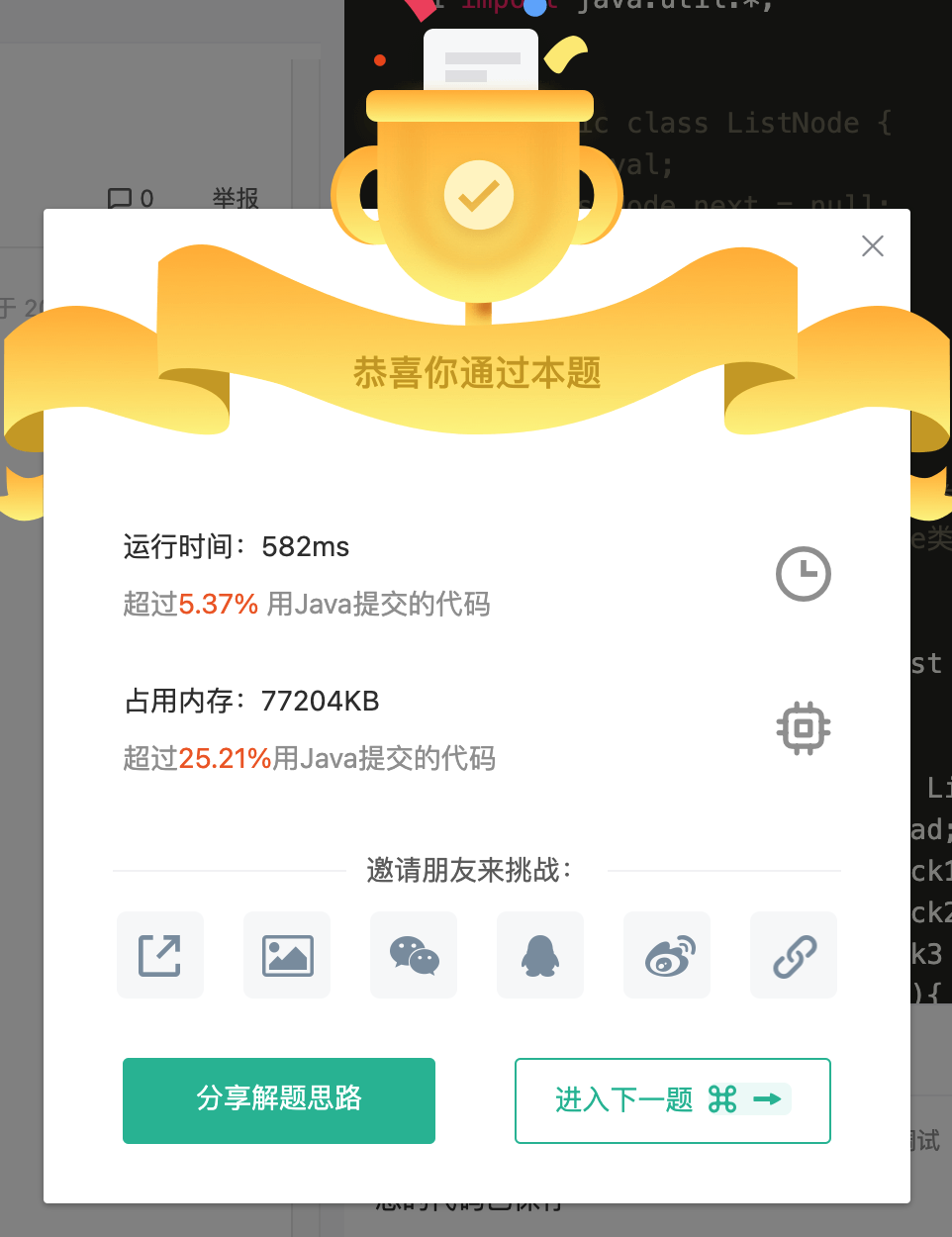
2022-07-16
508

原创
[百战LeetCode][13.两链表之和]
==========================努力奋斗财源广进==========================
一、算法题目
假设链表中每一个节点的值都在 0 - 9 之间,那么链表整体就可以代表一个整数。给定两个这种链表,请生成代表两个整数相加值的结果链表。

二、题解
1、我的题解
import java.util.*;
/*
* public class ListNode {
* int val;
* ListNode next = null;
* }
*/
public class Solution {
/**
*
* @param head1 ListNode类
* @param head2 ListNode类
* @return ListNode类
*/
public ListNode addInList (ListNode head1, ListNode head2) {
// write code here
//使用两个栈保存栈。
ListNode head = new ListNode(-1);
ListNode dummy = head;
Stack<ListNode> stack1 = new Stack<>();
Stack<ListNode> stack2 = new Stack<>();
Stack<Integer> stack3 = new Stack<>();
while(head1 != null){
stack1.push(head1);
head1 = head1.next;
}
while(head2 != null){
stack2.push(head2);
head2 = head2.next;
}
int count = 0;
while((!stack1.isEmpty()) && (!stack2.isEmpty())){
int sum = stack1.pop().val +stack2.pop().val;
if(count > 0){
sum += count;
count--;
}
if(sum > 9) {
sum = sum % 10;
count++;
}
stack3.push(sum);
}
while(!stack1.isEmpty()){
if(count > 0){
int sum = stack1.pop().val + count;
if(sum > 9){
stack3.push(0);
count++;
} else{
stack3.push(sum);
}
count--;
} else{
stack3.push(stack1.pop().val);
}
}
while(!stack2.isEmpty()){
if(count > 0){
int sum = stack2.pop().val + count;
if(sum > 9){
stack3.push(0);
count++;
} else{
stack3.push(sum);
}
count--;
} else{
stack3.push(stack2.pop().val);
}
}
if(count > 0) stack3.push(1);
while(!stack3.isEmpty()){
ListNode tmp = new ListNode(stack3.pop());
head.next = tmp;
head = head.next;
}
return dummy.next;
}
}

2、优秀题解
public ListNode addInList (ListNode head1, ListNode head2) {
// 进行判空处理
if(head1 == null)
return head2;
if(head2 == null){
return head1;
}
// 反转h1链表
head1 = reverse(head1);
// 反转h2链表
head2 = reverse(head2);
// 创建新的链表头节点
ListNode head = new ListNode(-1);
ListNode nHead = head;
// 记录进位的数值
int tmp = 0;
while(head1 != null || head2 != null){
// val用来累加此时的数值(加数+加数+上一位的进位=当前总的数值)
int val = tmp;
// 当节点不为空的时候,则需要加上当前节点的值
if (head1 != null) {
val += head1.val;
head1 = head1.next;
}
// 当节点不为空的时候,则需要加上当前节点的值
if (head2 != null) {
val += head2.val;
head2 = head2.next;
}
// 求出进位
tmp = val/10;
// 进位后剩下的数值即为当前节点的数值
nHead.next = new ListNode(val%10);
// 下一个节点
nHead = nHead.next;
}
// 最后当两条链表都加完的时候,进位不为0的时候,则需要再加上这个进位
if(tmp > 0){
nHead.next = new ListNode(tmp);
}
// 重新反转回来返回
return reverse(head.next);
}
// 反转链表
ListNode reverse(ListNode head){
if(head == null)
return head;
ListNode cur = head;
ListNode node = null;
while(cur != null){
ListNode tail = cur.next;
cur.next = node;
node = cur;
cur = tail;
}
return node;
}
三、解法心得
自己解法显然是过于复杂,没有使用技巧的简单化解法,完全不顾及占用空间和消耗的时间,优点是能够顺利通过用例。
优秀解法是使用了反转链表,空间复杂度就为O(1)时间复杂度为M+N。思路相对来说还是比较清晰的。后面可以整体复习下。
四、自我监督
评论区记录复习记录
算法刷题



评论